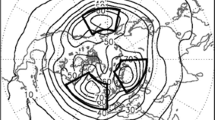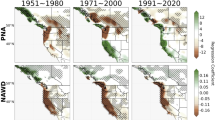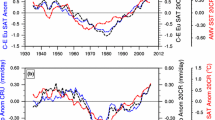Abstract
The North Atlantic Oscillation (NAO) is the most recognized and leading mode of atmospheric variability observed over the Atlantic sector of the Northern Hemisphere, and its impacts on weather and climate over the North Atlantic and Eurasia via large-scale teleconnections have been extensively studied. Here we use a multidata synthesis approach to analyze surface and tropospheric variables from multiple long-term observational and reanalysis datasets to identify the NAO’s footprint on interannual temperature variability over the vast but least-studied Sahara Desert during December–January–February–March for the satellite era (1979–2022) and century-long periods. Our results present evidence for a solid teleconnection pattern in surface and tropospheric temperatures associated with the NAO over the Sahara and document some major spatial–temporal and vertical characteristics of this pattern. It is found that the Saharan temperature anomalies are negatively correlated with the NAO index and this correlation is very strong, consistent, and statistically significant between different periods and across different datasets. The teleconnection is closely linked to large-scale circulation anomalies throughout the troposphere over the North Atlantic–Sahara sector, where the anomalous horizontal wind components and geopotential height exhibit opposite changes in sign with altitude from the lower to upper troposphere. During the negative NAO− (positive NAO+) phase, above-normal (below-normal) temperatures over the Sahara could be mainly explained by three major processes: (1) advection of climatological warm and moist (cold and dry) air over the North Atlantic (northern higher latitudes) by the anomalous southwesterly (northeasterly) flow in the lower troposphere; (2) advection of anomalous North Atlantic warm (cold) air by the climatological strong westerlies in the middle and upper troposphere; and (3) strengthened (weakened) vertical mixing in the atmospheric boundary layer. These results suggest that the NAO plays an important role in modulating the interannual temperature variability over the Sahara, and that this NAO footprint is mostly realized through horizontal temperature advection and vertical heat transfer by turbulent mixing.















Similar content being viewed by others
Data availability
The NCAR NAOI dataset was downloaded from https://climatedataguide.ucar.edu/climate-data/ and the NOAA NAOI dataset was downloaded from https://www.ncdc.noaa.gov/teleconnections/nao/. The NASA’s GISTEMP dataset was downloaded from https://data.giss.nasa.gov/gistemp/. The BEST dataset was downloaded from https://berkeleyearth.org/data/. The ERA5 reanalysis was downloaded from https://cds.climate.copernicus.eu/#!/search?text=ERA5&type=dataset. The second Modern-Era Retrospective Analysis for Research and Applications (MERRA-2) was downloaded from https://gmao.gsfc.nasa.gov/reanalysis/MERRA-2/data_access/. The GHCNMv4 was downloaded from https://www.ncei.noaa.gov/pub/data/ghcn/v4/. The 20CRv3 was downloaded from http://apdrc.soest.hawaii.edu/datadoc/20century_reanalysisV3.php). The CERA-20C was downloaded from https://www.ecmwf.int/en/forecasts/datasets/reanalysis-datasets/cera-20c.
References
Agrawal S, Ferguson CR, Bosart L, Burrows DA (2021) Teleconnections governing the interannual variability of great plains low-level jets in May. J Climate 34:4785–4802. https://doi.org/10.1175/JCLI-D-20-0451.1
Barnston AG, Livezey RE (1987) Classification, seasonality and persistence of low-frequency atmospheric circulation patterns. Mon Weather Rev 115:1083–1126
Castañeda IS et al (2009) Wet phases in the Sahara/Sahel region and human migration patterns in North Africa. Proc Natl Acad Sci USA 106:20159–20163
Chen WY, van den Dool H (2003) Sensitivity of teleconnection patterns to the sign of their primary action center. Mon Weather Rev 131:2885–2899
Clark JP, Feldstein SB (2020a) What drives the North Atlantic Oscillation’s temperature anomaly pattern? Part I: the growth and decay of the surface air temperature anomalies. J Atmos Sci 77:185–198. https://doi.org/10.1175/JAS-D-19-0027.1
Clark JP, Feldstein SB (2020b) What drives the North Atlantic Oscillation’s temperature anomaly pattern? Part II: a decomposition of the surface downward longwave radiation anomalies. J Atmos Sci 77:199–216. https://doi.org/10.1175/JAS-D-19-0028.1
Collins JM (2011) Temperature variability over Africa. J Climate 24(14):3649–3666. https://doi.org/10.1175/2011JCLI3753.1
Cook KH, Vizy EK (2015) Detection and analysis of an amplified warming of the Sahara Desert. J Climate 28:6560–6580. https://doi.org/10.1175/JCLI-D-14-00230.1
Dai L, Wright JS (2021) Long-term variability of relationships between potential large-scale drivers and summer precipitation in North China in the CERA-20C reanalysis. Atmosphere 12:81. https://doi.org/10.3390/atmos12010081
Dalelane C, Winderlich K, Walter A (2023) Evaluation of global teleconnections in CMIP6 climate projections using complex networks. Earth Syst Dyn 14:17–37. https://doi.org/10.5194/esd-14-17-2023
Evan AT, Flamant C, Lavaysse C, Kocha C, Saci A (2015) Water vapor–forced greenhouse warming over the Sahara desert and the recent recovery from the Sahelian drought. J Climate 28:108–123. https://doi.org/10.1175/JCLI-D-14-00039
Gelaro R et al (2017) The modern-era retrospective analysis for research and applications, version 2 (MERRA-2). J Climate 30(14):5419–5454. https://doi.org/10.1175/JCLI-D-16-0758.1
GISTEMP Team (2021) GISS Surface Temperature Analysis (GISTEMP), version 4. NASA Goddard Institute for Space Studies. https://data.giss.nasa.gov/gistemp/
Hersbach H et al (2020) The ERA5 global reanalysis. Q J R Meteorol Soc 146(730):1999–2049. https://doi.org/10.1002/qj.3803
Hurrell JW (1995) Decadal trends in the North Atlantic oscillation: regional temperatures and precipitation. Science 269:676–679
Hurrell JW (1996) Influence of variations in extratropical wintertime teleconnections on Northern Hemisphere temperature. Geophys Res Lett 23(6):665–668
Hurrell JW, Deser C (2009) North Atlantic climate variability: the role of the North Atlantic Oscillation. J Mar Syst 78(1):28–41
Hurrell JW, Kushnir Y, Ottersen G, Visbeck M (2003) An overview of the North Atlantic Oscillation. In: Hurrell JW, Kushnir Y, Ottersen G, Visbeck M (eds) The North Atlantic Oscillation: climatic significance and environmental impact. https://doi.org/10.1029/134GM01.
Knippertz P, Todd MC (2012) Mineral dust aerosols over the Sahara: meteorological controls on emission and transport and implications for modeling. Rev Geophys 50:RG1007. https://doi.org/10.1029/2011RG000362
Laloyaux P, de Boisseson E, Balmaseda M, Bidlot J-R, Broennimann S, Buizza R et al (2018) CERA-20C: a coupled reanalysis of the twentieth century. J Adv Model Earth Syst 10:1172–1195. https://doi.org/10.1029/2018MS001273
Lamb PJ, Peppler RA (1987) North Atlantic Oscillation: concept and application. Bull Am Meteorol Soc 68:1218–1225
Lau WK, Kim KM (2015) Robust Hadley circulation changes and increasing global dryness due to CO2 warming from CMIP5 model projections. Proc Natl Acad Sci USA 112(12):3630–3635. https://doi.org/10.1073/pnas.1418682112
Lenssen N, Schmidt G, Hansen J, Menne M, Persin A, Ruedy R, Zyss D (2019) Improvements in the GISTEMP uncertainty model. J Geophys Res Atmos 124(12):6307–6326. https://doi.org/10.1029/2018JD029522
Li J, Ruan C (2018) 2018, The North Atlantic-Eurasian teleconnection in summer and its effects on Eurasian climates. Environ Res Lett 13:024007. https://doi.org/10.1088/1748-9326/aa9d33
Ma X, Zhang Y (2018) Interannual variability of the North Pacific winter storm track and its relationship with extratropical atmospheric circulation. Clim Dyn 51:3685–3698. https://doi.org/10.1007/s00382-018-4104-8
Martineau P, Nakamura H, Kosaka Y et al (2020) Importance of a vertically tilting structure for energizing the North Atlantic Oscillation. Sci Rep 10:12671. https://doi.org/10.1038/s41598-020-69551-5
McHugh MJ, Rogers JC (2001) North Atlantic Oscillation influence on precipitation variability around the Southeast African Convergence Zone. J Climate 14:3631–3642
Meehl GA, van Loon H (1979) The seesaw in winter temperatures between Greenland and northern Europe. Part III: teleconnections with lower latitudes. Mon Weather Rev 107:1095–1106
Menne MJ, Williams CN, Gleason BE, Rennie JJ, Lawrimore JH (2018) The global historical climatology network monthly temperature dataset, Version 4. J Climate. https://doi.org/10.1175/JCLI-D-18-0094.1
Menviel L, Govin A, Avenas A et al (2021) Drivers of the evolution and amplitude of African Humid Periods. Commun Earth Environ 2:237. https://doi.org/10.1038/s43247-021-00309-1
Moulin C, Lambert CE, Dulac F, Dayan U (1997) Control of atmospheric export of dust from North Africa by the North Atlantic Oscillation. Nature 387(6634):691
Nie Y, Ren H-L, Scaife AA (2020) Enhanced mid-to-late winter predictability of the storm track variability in North Pacific as a contrast with North Atlantic. Environ Res Lett 15:094037. https://doi.org/10.1088/1748-9326/ab9c4d
Nigam S, Baxter S (2015) Teleconnections. In: Gerald R. North (editor-in-chief), Pyle J, Zhang F (eds) Encyclopedia of atmospheric sciences, 2nd edn, vol 3, pp 90–109 (ISBN: 9780123822253)
Osborn TJ (2011) Winter 2009/2010 temperatures and a record-breaking North Atlantic Oscillation index. Weather 66:19–21. https://doi.org/10.1002/wea.660
Pausata FS et al (2020) The greening of the Sahara: past changes and future implications. One Earth 2:235–250
Pinto JG, Raible CC (2012) Past and recent changes in the North Atlantic oscillation. Wires Clim Change 3:79–90. https://doi.org/10.1002/wcc.150
Qin M, Dai A, Hua W (2020) Aerosol-forced multidecadal variations across all ocean basins in models and observations since 1920. Sci Adv. https://doi.org/10.1126/sciadv.abb0425
Rogers JC, van Loon H (1979) The seesaw in winter temperatures between Greenland and northern Europe. Part II: some oceanic and atmospheric effects in middle and high latitudes. Mon Weather Rev 107:509–519
Rohde RA, Hausfather Z (2020) The Berkeley Earth land/ocean temperature record. Earth Syst Sci Data 12:3469–3479. https://doi.org/10.5194/essd-12-3469-2020
Slivinski LC et al (2019) Towards a more reliable historical reanalysis: improvements for version 3 of the Twentieth Century Reanalysis system. Q J Roy Meteorol Soc 145:2876–2908. https://doi.org/10.1002/qj.3598
Stephenson D, Pavan V, Participating CMIP1 Modelling Groups (2003) The North Atlantic Oscillation in coupled climate models: a CMIP1 evaluation. Clim Dyn 20:381–399. https://doi.org/10.1007/s00382-002-0281-5
Thomas N, Nigam S (2017) Twentieth-century climate change over Africa: seasonal hydroclimate trends and Sahara Desert expansion. J Climate 31:3349–3370. https://doi.org/10.1175/JCLI-D-17-0187.1
Thompson DWJ, Lee S, Baldwin MP (2003) Atmospheric processes governing the northern hemisphere annular mode/north Atlantic oscillation. In: Ottersen G, Hurrell JW, Visbeck M, Kushnir Y (eds) The North Atlantic Oscillation: climatic significance and environmental impact, geophysical monograph series; Vol. 134. Blackwell Publishing Ltd, pp 81–112. https://doi.org/10.1029/134GM05
Thorne PW, Vose RS (2010) Reanalyses suitable for characterizing long-term trends. Bull Am Meteorol Soc 91:353–362. https://doi.org/10.1175/2009BAMS2858.1
van den Dool HM, Saha S, Johansson Å (2000) Empirical orthogonal teleconnections. J Climate 13:1421–1435
van Loon H, Rogers JC (1978) The seesaw in winter temperatures between Greenland and northern Europe. Part I: general description. Mon Weather Rev 106:296–310
Visbeck MH, Hurrell JW, Polvani L, Cullen HM (2001) The North Atlantic Oscillation: past, present, and future. Proc Natl Acad Sci USA 98(23):12876–12877. https://doi.org/10.1073/pnas.231391598
Vizy EK, Cook KH (2017) Seasonality of the observed amplified Sahara warming trend and implications for Sahel rainfall. J Climate. https://doi.org/10.1175/JCLI-D-16-0687.1
Wallace JM, Gutzler DS (1981) Teleconnections in the geopotential height field during the Northern Hemisphere Winter. Mon Wea Rev 10:784
Washington R, James R, Pearce H, Pokam WM, Moufouma-Okia W (2013) Congo Basin rainfall climatology: can we believe the climate models? Philos Trans R Soc B 368:20120296
Watanabe M (2004) Asian jet waveguide and a downstream extension of the North Atlantic Oscillation. J Climate 17:4674–4691. https://doi.org/10.1175/JCLI-3228.1
Wei N, Zhou L, Dai Y (2017) Observational evidence for desert amplification using multiple satellite datasets. Sci Rep 7:2043. https://doi.org/10.1038/s41598-017-02064-w
Wohland J, Brayshaw D, Bloomfield H, Wild M (2020) European multidecadal solar variability badly captured in all centennial reanalyses except CERA20C. Environ Res Lett 15(104):021. https://doi.org/10.1088/1748-9326/aba7e6
Woollings T, Hoskins B, Blackburn M, Berrisford P (2008) A new Rossby wave–breaking interpretation of the North Atlantic Oscillation. J Atmos Sci 65:609–626. https://doi.org/10.1175/2007JAS2347.1
Wright DK (2016) Humans as agents in the termination of the African humid period. Front Earth Sci. https://doi.org/10.3389/feart.2017.00004
Wu GX, Liu Y, Zhu X, Li W, Ren R, Duan A, Liang X (2009) Multi-scale forcing and the formation of subtropical desert and monsoon. Ann Geophys 27:3631–3644
Yamagata T, Behera SK, Luo JJ, Masson S, Jury MR, Rao SA (2004) Coupled Ocean-Atmosphere variability in the tropical Indian Ocean. Geophys Monogr 147:189–211. https://doi.org/10.1029/147GM12
Zhang Z, Ramstein G, Schuster M et al (2014) Aridification of the Sahara desert caused by Tethys Sea shrinkage during the Late Miocene. Nature 513:401–404. https://doi.org/10.1038/nature13705
Zhou L (2016) Desert amplification in a warming climate. Sci Rep 6:31065. https://doi.org/10.1038/srep31065
Zhou L (2021) Diurnal asymmetry of desert amplification and its possible connections to planetary boundary layer height: a case study for the Arabian Peninsula. Clim Dyn 56:3131–3156. https://doi.org/10.1007/s00382-021-05634-x
Zhou L, Chen H, Dai Y (2015) Stronger warming amplification over drier ecoregions observed since 1979. Environ Res Lett 10:064012. https://doi.org/10.1088/1748-9326/10/6/064012
Zhou L, Chen H, Hua W, Dai Y, Wei N (2016) Mechanisms for stronger warming over drier ecoregions observed since 1979. Clim Dyn. https://doi.org/10.1007/s00382-016-3007-9
Zhou L, Tian Y, Wei N, Ho S-P, Li J (2021) Rising planetary boundary layer height over the Sahara Desert and Arabian Peninsula in a warming climate. J Clim 34(10):4043–4068. https://journals.ametsoc.org/view/journals/clim/34/10/JCLI-D-20-0645.1.xml.
Acknowledgements
We would like to thank Daniel Keyser at UAlbany for frequent discussions and extensive comments on this work. L.Z. was supported by the National Science Foundation (NSF AGS-1952745 and AGS-1854486). W.H. was supported by the National Natural Science Foundation of China (42075022). Support for the Twentieth Century Reanalysis Project version 3 dataset is provided by the U.S. Department of Energy, Office of Science Biological and Environmental Research (BER), by the National Oceanic and Atmospheric Administration Climate Program Office, and by the NOAA Earth System Research Laboratory Physical Sciences Laboratory.
Funding
This work is supported by the National Science Foundation (NSF AGS-1952745 and AGS-1854486). W.H. was supported by the National Natural Science Foundation of China (42075022).
Author information
Authors and Affiliations
Contributions
All authors contributed to the study conception and design. Data collection and analysis were performed by LZ and WH. The initial manuscript was written by LZ. All authors contributed to the interpretation of results and commented on the previous versions of the manuscript. All authors read and approved the final manuscript.
Corresponding author
Ethics declarations
Conflict of interest
The authors have no relevant financial or non-financial interests to disclose.
Additional information
Publisher's Note
Springer Nature remains neutral with regard to jurisdictional claims in published maps and institutional affiliations.
Rights and permissions
Springer Nature or its licensor (e.g. a society or other partner) holds exclusive rights to this article under a publishing agreement with the author(s) or other rightsholder(s); author self-archiving of the accepted manuscript version of this article is solely governed by the terms of such publishing agreement and applicable law.
About this article
Cite this article
Zhou, L., Hua, W., Nicholson, S.E. et al. Interannual teleconnections in the Sahara temperatures associated with the North Atlantic Oscillation (NAO) during boreal winter. Clim Dyn 62, 1123–1143 (2024). https://doi.org/10.1007/s00382-023-06962-w
Received:
Accepted:
Published:
Issue Date:
DOI: https://doi.org/10.1007/s00382-023-06962-w




